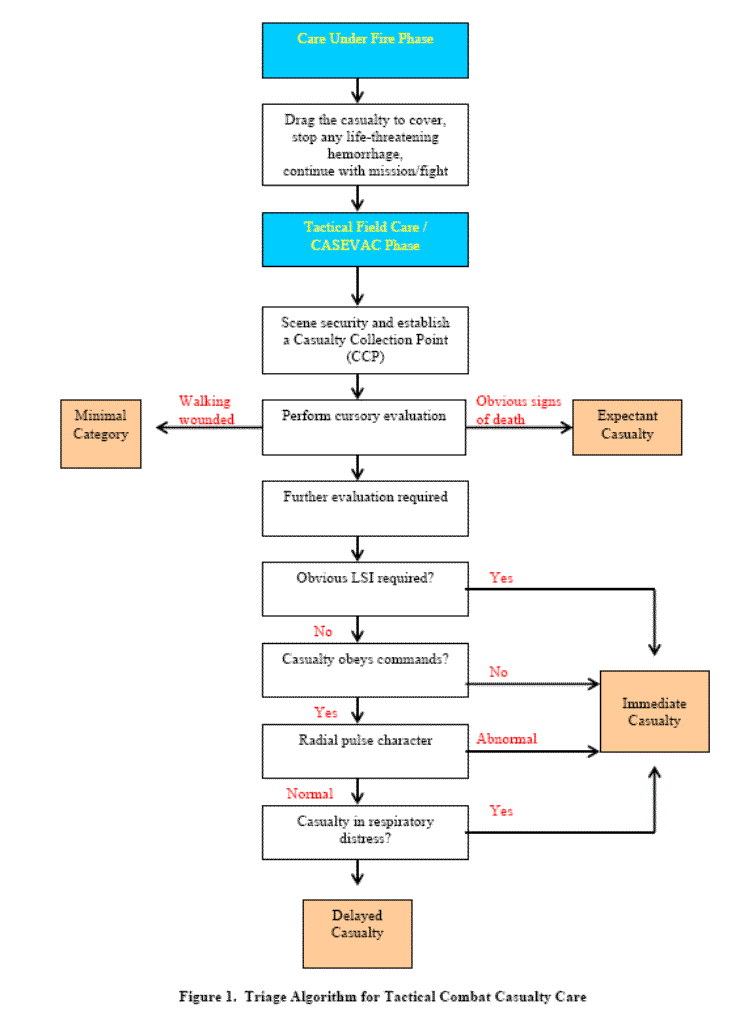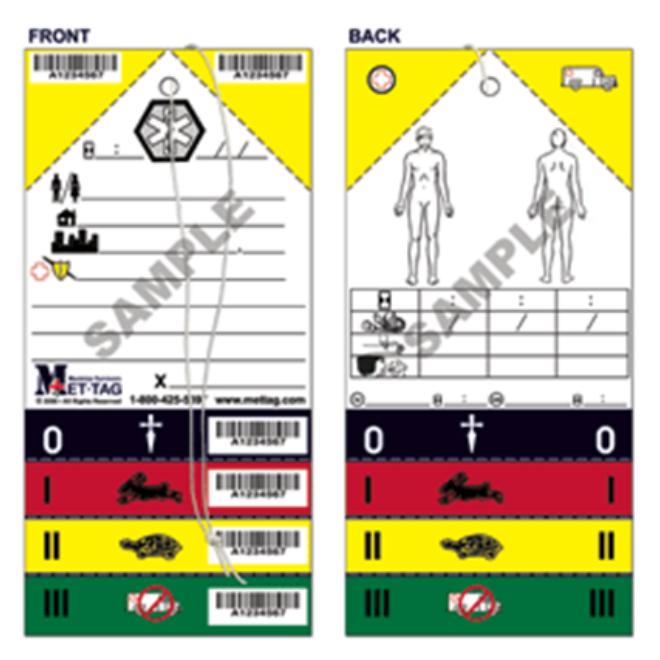TERMINAL LEARNING OBJECTIVES
1.
Given multiple casualties in a simulated
combat environment, standard field medical equipment and supplies,
conduct triage to identify triage categories for medical treatment,
per the references. (FMST-HSS-1421)
2.
Given multiple casualties in an
operational environment, necessary medical equipment and supplies,
manage mass casualty incident, per the references. (FMST-HSS-1422)
ENABLING LEARNING OBJECTIVES
1.
Without the aid of references, given a
description or list, identify the tactical principles of triage, per
the student handout. (FMST-HSS-1421a)
2.
Without the aid of references, given a
descriptive list of injuries, identify the appropriate triage
categories for specific injuries, per the student handout.
(FMST-HSS-1421b)
3.
Given multiple casualties in an
operational environment, necessary medical equipment and supplies,
coordinate a mass casualty incident, per the references.
(FMST-HSS-1422a)
1.
TACTICAL TRIAGE
Triage
is a French word meaning “to sort”. Casualties are sorted into groups
based on their immediate medical needs. Using a standardized approach
to triage casualties helps combat medics correctly segregate, treat,
and prioritize evacuation in the shortest time possible. The
realities of combat dictate that battlefield triage must take place in
an environment limited in resources for treatment and transport.
Triaging casualties merely establishes order of treatment and movement
(see box 1). Although all casualties require treatment, triage aids
the Corpsman in deciding which casualties have the greatest
probability of survival and helps weigh the casualties need for
lifesaving interventions (LSIs), thus determining priority and urgency
for treatment and evacuation.
Triage establishes the patients’ category. Although
the type and extent of the wound may offer clues as to the triage
category a patient may fall into, it is their physiological state (how
well there body is working) that is the critical factor. For
instance, a patient with a weak radial pulse indicates an estimated
systolic blood pressure of 80 mm/Hg. Studies of combat related
injuries indicate that 32% of these individuals will die. The absence
of a radial pulse indicates a systolic blood pressure of less than 50
mm/Hg. The same study reported that 92% of these individuals will
die. On the other hand, a separate trauma study indicated that no
casualty died if they presented during the first stages of triage with
a palpable radial pulse and the ability to follow simple commands.
2.
PRINCIPLES OF TACTICAL TRIAGE
- Accomplish the greatest good for the greatest number
of casualties
- Employ the most efficient use of available resources
- Return personnel to duty as soon as possible
3.
THE FOUR CATEGORIES OF TACTICAL TRIAGE
Categories are color coded and are
recognized as follows:
MINIMAL (GREEN TAG)
Also known as the “walking wounded.”
Although these patients may appear to be in bad shape at first,
remember, it is their physiological state that tells the true story.
Examples include but are not limited
to – small burns, lacerations, abrasions, and small fractures.
These casualties have minor injuries
and can usually care for themselves with self-aid or “buddy aid”.
These casualties should still be employed for mission requirements
(e.g., scene security).
DELAYED (YELLOW TAG)
The delayed category includes wounded
casualties who may need surgery, but whose general condition permits a
delay in surgical treatment without unduly endangering life or limb.
Medical treatment (splinting, pain control, etc.) will be required but
it can wait.
Examples include but are not limited
to – casualties with no evidence of shock who have large soft tissue
wounds, fractures of major bones, intra-abdominal or thoracic wounds,
or burns to less than 20% of total body surface area.
Box 1: Triage in Tactical Combat Casualty Care (TCCC)
IMMEDIATE (RED TAG)
The immediate category includes
casualties who require immediate LSI and/or surgery. Put simply, if
medical attention is not provided, the patient will die. The key to
successful triage is to locate these individuals as quickly as
possible. Casualties do not remain in this category for an extended
period of time, they are either found, triaged and treated, or they
will die!
Examples include but are not limited to –
hemodynamically unstable casualties with airway obstruction, chest or
abdominal injuries, massive external bleeding, or shock.
EXPECTANT (BLACK TAG)
Casualties in this category have
wounds that are so extensive that even if they were the sole casualty
and had the benefit of optimal medical resources, their survival would
be highly unlikely. Even so, expectant casualties should not be
neglected. They should receive comfort measures, pain medications, if
possible, and they deserve re-triage as appropriate.
Examples include but are not limited
to – casualties with penetrating or blunt head wounds and those with
absent radial pulses.
4.
Because the tactical environment precludes an extensive array of
monitoring equipment, optimal battlefield treatment and evacuation
rely on simple triage tools. Based on research by the Committee on Tactical Combat
Casualty Care, a triage decision algorithm has been developed (see
figure 1). Using this method will enable the FMST to perform an
initial triage of many individuals in a quick and systematic manner.
- Patients who
can ambulate and follow instructions usually will fall into the
minimal category. Statements such as “If you can hear my voice get up
and move behind the building” (or any other place tactically correct)
can triage a large portion of the casualties in a short time.
- Patients with obvious signs of death can be
initially placed in the expectant category.
- Casualties who do not fit either of the above
categories will need further evaluation.
- Massive
bleeding is the most obvious sign of the need for a LSI. It may need
a tourniquet, a hemostatic agent, or a pressure bandage.
- Once the LSI has been performed the patient is
immediately re-triaged.
- According to
the algorithm, patients are placed in the delayed category if they can
obey simple commands, possess a normal radial pulse, and are not in
respiratory distress.

5. MASS-CASUALTY TRIAGE
Corpsmen operating in a tactical
environment must always be prepared to deal with a mass casualty
incident. Units must establish and rehearse plans for dealing with
such a situation. In a mass casualty situation those responsible for
triage must remember that triage is not treatment and constant
reassessment is needed to identify casualties who may have
deteriorated or improved.
6. TRIAGE TAGS
Triage tags are designed to
communicate the triage category, treatment rendered, and other medical
information. By necessity, the information on the tag is brief.
Triage tags are usually placed on the casualty by the triage officer
although other members of the team may place or add information to the
tags.
NATO Card (METTAG: Medical
Emergency Triage Tag) (see figure 2)
Purpose
- To furnish the attending care provider during the
evacuation of a casualty with essential information about the injury
or disease and the treatment provided.
- The sole or initial medical record for the troops
injured in combat.
- Each triage
tag is coded with a unique sequential seven-character serial number
used for identification and tracking of the casualty. The serial
number is located on the top right and left diagonal tear-offs.
Routing
- The card stays with the patient at all times.
- The yellow corner with the ambulance picture and a
serial number stays with the evacuating vehicle.
- The yellow corner with the first aid sign and serial
number stays at the BAS.


